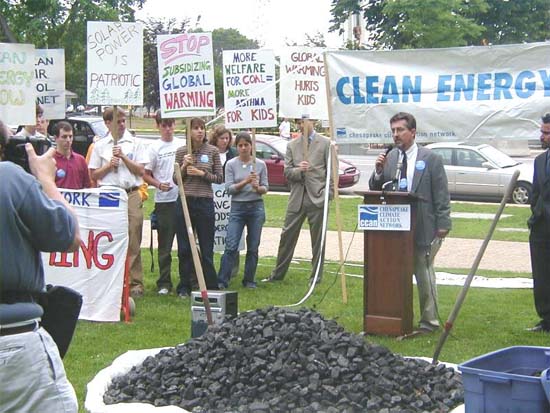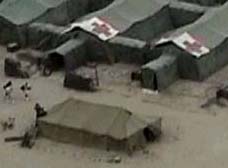
In 2003, when Bayou Farewell was published, few Americans had any idea what was going on "down 'da baya." Local politicians continued to drag their feet, mainstream media continued to avoid the matter, and most of our country's major conservation groups remained conspicuously absent while a vast ecology and billion-dollar seafood industry edged towards the point of collapse. Author Mike Tidwell, founder of the Chesapeake Climate Action Committee, served as a Peace Corps Volunteer in Congo Kinshasa.
Mike Tidwell says Louisiana Bayou has been sinking for years, and now it's almost gone—taking New Orleans and Cajun culture with it
Bayou Farewell
News: The Louisiana Bayou has been sinking for years, and now it's almost gone—taking New Orleans and Cajun culture with it.
Mike Tidwell
Interviewed By Erik Kancler
October 3, 2005
Mike Tidwell knew nothing about the environmental perils facing the Louisiana Bayou when the Washington Post sent him down there, in the spring of 1999, to write about Cajun culture. Yet, having hit on the idea of “hitchhiking” the shrimp and crab boats of the Bayou, he soon came upon numerous and puzzling signs that something was seriously awry in Bayou Country: groves of sun-bleached and leafless Oak trees, half-drowned and hundreds of feet from land; lines of telephone poles planted in swampland; cemeteries where only the tops of graves remained visible.
Bewildered, he asked the locals for an explanation, and everywhere he heard variations on the same theme---from shrimpers, crabbers, and fishermen, no less than from local scientists and conservationists. In the words of a local shrimp-boat captain, upon whose vessel Tidwell first hitched a ride, "All dis land around us, as far as you can see, is droppin' straight down into de water, turnin' to ocean. Someday, Baton Rouge, one hundred miles nort' of here, is gonna be beachfront property."
As Tidwell recounts in Bayou Farewell, the book that emerged from this experience, the problem had begun in 1927, when massive flooding of the Mississippi River prompted the U.S. Government to direct its Army Corps of Engineers to construct a massive levee system, designed to keep the river from ever breaching its banks again. Although this had the intended effect of keeping cities, towns, and farmland dry, all the sediment carried by the mighty river, instead of fanning out and settling throughout the Bayou, creating land as it did so, was now swept straight over the edge of the continental shelf and down to the bottom of the ocean. Stripped of its supply of fresh sediment, the Bayou began a relatively swift descent into the ocean.
In 2003, when Bayou Farewell was published, few Americans had any idea what was going on "down 'da baya." Local politicians continued to drag their feet, mainstream media continued to avoid the matter, and most of our country's major conservation groups remained conspicuously absent while a vast ecology and billion-dollar seafood industry edged towards the point of collapse.
Perhaps most significant of all, the loss of Bayou set the stage for one our country's most devastating and costly disasters: Hurricane Katrina. Decades of erosion to barrier islands, many of which exist today only as unseen shoals of sand, as well as disappearing marshes, wetlands, and coastal forests means that the rising tide which accompanies a Gulf Hurricane's march to the coast could slam head-on into the many miles of levees designed to keep New Orleans if not high, then at least dry. It was only a matter of time before Katrina became a reality. Local conservationists knew it. Scientists knew it. Engineers knew it. All of whom screamed to the Louisiana State Government, who also knew it, yet did almost nothing to reverse the loss of land.
By 1999, Mike Tidwell knew it too. And with Bayou Farewell, he has crafted the first, the best, and certainly the most elegantly written account of Louisiana's tragedy, an endeavor in which he attempts to thrust the problem to national attention, providing an education to readers as well as a window to a unique and imperiled way of life. In Bayou Farewell, Tidwell's narrative recalls the sheer horror of learning about the tragedy first-hand, while simultaneously immersing the reader in the sights, sounds, smells, and joie de vivre of Cajun culture, as well as the pristine beauty of the delicate natural world in which it is embedded.
In the wake of Katrina, Tidwell has become a much sought-after expert on the disaster. He speaks of the need to turn our gaze to the future, not just for the sake of New Orleans and Louisiana's Bayou, but to address the issue of global climate change, which in a few decades could put many of the world's population centers and billions of people of risk of a similar fate. Tidwell, who is getting ready to undertake his sixth book, a follow-up to Bayou Farewell focusing on these problems, talked to Mother Jones from his home near Washington DC.
Mother Jones: You're one of the first people to bring widespread attention to the risks of a major hurricane devastating New Orleans. How did you get into writing about this?
Mike Tidwell: I stumbled on the story in South Louisiana in 1999. I was asked by the Sunday travel editor of the Washington Post to go to Louisiana and write whatever I wanted as long as it didn't involve New Orleans. He wanted me to get out into the hinterlands, and I love water, I love boats, I love fishing, so I was drawn to the Cajun Bayou. I was seeking an original way to interpret this amazing culture and I hit on the idea of hitchhiking up and down the Bayous of South Louisiana with just a backpack, getting rides on shrimp boats, crab boats, and fishing boats, and I had this amazing experience.
MJ:What did you find there?
MT: In my estimation, the Cajun Bayou region of Louisiana, at least before Katrina, was the most distinctive and culturally rich region in America. You have three quarters of a million people throughout Cajun land, and they are utterly self-reliant people, especially the ones who live in the marshes. They build their own boats, build their own homes, live according to the rhythms of the natural world. Many of whom don't know how to read or write, yet they can spend hours discussing the intricate inner workings of wind, current, and tide, or build a wooden boat with no blueprints. And I don't know that I've ever met a Cajun who said that their goal is to be a millionaire. If you ask them what they want to be doing ten years from now, they'll say, "Shrimpin'! Preferably with my five year old son!" They are content with their lot for the most part to just keep doing what they're doing, celebrating their unique way of life.
The Cajun Bayou culture, grew from the marshes, the swamps, and bayous, creating a people who have lived in isolation, and want mostly to be left alone to live off their land, practice their Catholic faith, drink their wine and beer, eat their great food, and speak their own language. These people are simply different spiritually, emotionally, linguistically, historically from all the rest of America.
MJ:But that culture is now under threat.
MT: Right. Cajuns will tell you, when the marsh was intact, their culture was intact. But when the marsh started to fragment and disappear, and the barrier islands started to vanish, the same thing started happening to the culture.
And that's when I stumbled on the story of what at the time I recognized as the greatest untold story in America: the utter calamity of vanishing land along the Louisiana Coast. It was June of 1999 when I made that first trip, and Cajun shrimpers and crabbers, many of them high school dropouts, most of whom speak French better than they speak English, schooled me—a journalist who has traveled all over the world, been to graduate school, and considers himself a serious conservationist—on the greatest environmental calamity in America.
They showed me cemeteries lying in open water, forests of oak trees standing bleached and leafless like unburied bones hundreds of feet from land. They showed me the two lane roads next to which telephone polls are in standing water because the shoulders have turned to water. And they explained to me why this was happening. They explained that the whole landform of South Louisiana was sinking and that this was brought on by the levees of the Mississippi River.
It wasn't long after when something much bigger hit me: I realized that Katrina was coming. I mean, it was just so obvious. And you can read in my book, where I say that New Orleans is an endangered city, and that it's not implausible that a hurricane, coming from the right direction at the right strength, could totally inundate and destroy the city and cause thousands of deaths. Of course, I haven't been the only one saying that.
MJ: This whole story really starts with the great flood of 1927 and the construction of levee system. Could you walk us through what's happened?
MT: Well, the levees along this Mississippi River were actually started by the French roughly 300 years ago. But they were carried forward by the ambitious engineering feats of the Army Corps of Engineers throughout the 20th Century. The result is that they have utterly tamed the river: The entire lower portion of the river hasn't flooded since 1927, at least not until Katrina broke the levees.
Before the levees, the river would flood its banks, collecting and re-depositing sediment. As it did, it created marshes, swamps, and barrier islands. As a result of the levees, all that sediment now flows straight out to sea and as the existing alluvial sediment slowly compacts and turns to clay, without new deposits, the whole thing slips into the sea.
So, you know, you live by the levees and you die by the levees. The levees have made New Orleans habitable since the French arrived, and those same levees through their recent failures have rendered the city uninhabitable by obliterated the buffering landmass that traditionally made New Orleans a safe place to live. When the French arrived in Southern Louisiana, there were vast and dense hardwood forests, followed by vast stretches of freshwater marshes and swamps, followed by endless saltwater marshes, and finally a formidable network of barrier islands. Now, it's all almost completely gone.
But the problem is greater than that. Ten thousand miles of oil and gas industry channels have been scissored through the wetlands of South Louisiana since the 1930s. And as a result of erosion brought on by the daily action of tides and the wake of boats, those channels get bigger and bigger, doubling in width every fourteen years. So, while the entire land platform is sinking at a rate of 2-3 feet per century, it's also being eroded from the inside. Combine the two, and you have the fastest disappearing landmass on earth.
MJ: You wrote that there used to be roughly 50 miles between the City of New Orleans and the Gulf at its closest point. Now that distance is more like 20 miles, which in conjunction with the fact that every 2.7 miles of marsh reduces storm surges by roughly a foot, is a pretty big blow to hurricane protection. Obviously the breakage of levees has gotten a lot of press, but what role did the loss of Bayou play in the tragedy?
MT: There is a lot of talk of creating "Category 5" capable levees to protect the city. But Category 5 hurricane protection involves more than just levees. You can't keep building your way out of this problem through levees. Real protection can be accomplished only by restoring the barrier islands and wetlands.
For one thing, the land platform will continue to sink, which means the levees themselves sink. Are we literally going to build a "Fortress City" with these unbelievably huge, concrete re-enforced levees, which would need to be made taller every year and turn New Orleans into an isolated island destination for conventioneers and tourists, which can't be integrated with any sort of regional economy and culture because everything outside those levees is gone? That scenario is just obviously ridiculous, and if we as a nation want more than that, we have to do more than just build levees.
MJ: Speaking of the regional economy, there's a vast fishery down there, supported by a massive wetland ecology, both of which are now in peril.
MT: The ecological loss is staggering. Outside of the Amazon, I've never seen so many life forms thrive in so many different ways in one place. You look in the water and you've got red fish, drum, and channel mullets, you've got dolphins, shrimp and crabs—the water is just full of swimming creatures. And then in the Marsh you've all kinds of raccoons and muskrats and coyotes, and insect life which is scarcely to be believed. The variety of birds, many of which are migratory is also staggering.
As the habitat disappears, the fishery also disappears, and that's a loss which will be felt not just in Louisiana, but throughout the country. I mean, just think of all that seafood that we consume, 30% or more of our nation's seafood comes from Southern Louisiana, more than double the amount from all other Gulf Coast states.
MJ: I would think that there would be large-scale involvement in this problem, at the very least from conservationists.
MT: Well, there's some interest; whether there's enough, I don't know. We don't have the political leadership to do the kind of things that we need to do and a there's quite a lot to be done. I hope that in the wake of Katrina, the right amount of money will be appropriated to rebuild the coast and protect the habitat that's there.
MJ: This is probably a good point to talk about a plan that's been in the works, a controlled diversion of the river, which you refer to as the "Holy Grail" of coastal restoration hopes, but which has never really gotten anywhere politically. In the post-Katrina political environment, what are the prospects for such plans?
MT: Well, this plan used to be expensive, but it doesn't seem expensive anymore when you're talking about $200 billion to rebuild the coast. It's a $14 billion plan that would essentially re-engineer the coast, rebuilding landmasses, recreating marshes and swamps. In order to do that, you have to go back to the original land-builder herself, the Mississippi River, and get the sediment and nutrient rich waters of the river back into the marshes and back out to the barrier islands in a way that doesn't flood homes and drown children.
Now, there's a way to do that. You build dam like control structures right into the levees of the river, which would let water out in a controlled way into either pipelines or canals that would surgically guide the water right to where the buffering land masses are needed most. There are some engineers who say they can build the entire barrier islands in a year if given the proper resources.
MJ: Obviously, someone has been opposing this plan, otherwise it'd be done by now.
MT: Well, I can't imagine at this point that anyone, properly informed, can argue that this is not money well spent. I think most people realize that we have got to do something other than just rebuild the levees and fix the broken windows and cleanup the debris. I'm optimistic that this money will be appropriated. I'm less optimistic that once appropriated, it will be done properly. There's going to have to be a lot of public scrutiny to make sure the Army Corps and the Government and the State of Louisiana get it right.
MJ: The political process to get something done is obviously taking shape right now. How can people get involved to put the pressure on?
MT: The best way to learn about this is to visit www.crcl.org, which stands for Coalition to Restore Coastal Louisiana. They're leading the fight in Washington. There's already been a $60 billion emergency supplemental appropriation to deal with the disaster of Katrina. It's going to pay to rebuild the levees to a safer level, its going to pay to clean up the streets of New Orleans, to provide comfort and support to people who are homeless, to provide medical care, and to help the cities like Houston and Baton Rouge deal with evacuees.
But not one penny of that money is earmarked to prepare for the next Katrina. There's going to be probably one more big supplemental emergency appropriation from Congress to deal with the Gulf, and this $14 billion restoration plan has got to be in that package. If it's not, and if we do not commit as a nation to a full coastal restoration program to rebuild the barrier islands and wetlands then we are in effect committing an act of mass homicide by rebuilding the city. It would be criminally negligent to send people to go live in New Orleans or the other parts of that coast.
MJ: Let's assume the city is going to be rebuilt. Obviously, you have to take care of the levees and certainly you have to take care of wetland restoration, and recreating the barrier islands. What else, if anything, has to be done to prepare for the future?
MT: The real lesson from Katrina involves the law of unintended consequences. When the French started throwing up levees 300 years ago, they did so for perfectly rationale reasons – they didn't want their children to drown, they didn't want their crops inundated, they didn't want their property destroyed. They never intended for the coast to disappear, but that was the consequence of beginning such a profound interference in the basic natural hydrology of a force as big as the Mississippi River. In nature, everything is connected to everything. And if you fundamentally alter a significant component of a natural system you fundamentally alter all of it's major components.
Now, when we started a culture of mass automobile use in the West, it wasn't our intention to cause sea levels to rise, the arctic to melt, and record extreme weather events to become commonplace in the world, but that's what's happening. When you burn coal, oil, natural gas, one byproduct is carbon dioxide, which migrates into the atmosphere and traps heat.
MJ: So you're saying that even if $14 billion is spent to recreate the wetlands and the barrier islands of South Louisiana, and the are levees rebuilt, but we do nothing about global climate change, then the city still is going to be vulnerable?
MT: Exactly. The Bush Administration's own documents and data from its own agencies all say the same thing: global warming is real, it's about to intensify, it's driven by fossil fuels and one signature impact will be 1-3 feet of sea level rise in the next hundred years. Whether the coast of Louisiana sinks 2-3 feet per century, or sea level rises, you have the same impact.
There's a lot of scientific evidence that show that hurricanes have become more intense in the last 50 years. It's impossible to say that Katrina was in any way influenced by global warming, yet it's impossible to prove otherwise as well, as many skeptics have so boldly stated. Yet the kind of intensity we saw from a hurricane passing the Florida peninsula as a level one and reaching Louisiana as a level four, having passed over record high sea surface temperatures in between, that's the kind of hurricane we would see more of in a warmer world.
Certainly with sea level rise, you're going to see barrier islands worldwide disappear and buffering marshes diminish. You're going to see beaches eroded and developed land move closer to the ocean, which brings the hurricanes closer to people. So what Savannah, Georgia and San Diego, California and Houston, Texas, need right now in order to avoid the fate of New Orleans isn't giant seawalls, it's wind farms to replace coal fired electricity, hydrogen fuel-powered cars to replace gasoline internal combustion engines, and that's a connection that may be hard for people to make. But it’s a valid connection.
You want to know what these cities are all going to be obsessively committing time and resources to if nothing is done? Just turn on your T.V. today and look at New Orleans. That's the future.
Erik Kancler is an editorial fellow at MotherJones.com.












